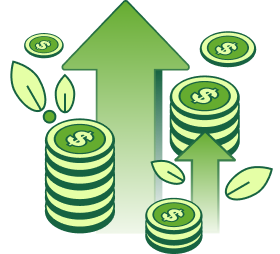Key takeaways
- You can finance home improvements with less than ideal credit by exploring personal loans, home equity options, and government programs.
- Home equity loans and HELOCs usually have lower interest rates, but you need sufficient equity to qualify.
- Always check eligibility without affecting your score and compare loans to find the best fit for your financial situation and budget.
Home improvements can add value to your home and make it more comfortable to live in. You could renovate your kitchen, fix the roof, or do an emergency repair. The problem is that most people don’t have the cash lying around to cover the costs out of pocket.
While paying for renovations can be a challenge, there are several ways to overcome it. We’ll review the best home improvement loan options, from tapping into your equity to a cash-out refinance, and more.
Do I need to take a loan for home repairs?
Whether or not you need to take out a loan for home repairs depends on the urgency of the issue, your financial situation, and the size of the project. If it’s a minor repair, you may be able to cover the cost from your savings, avoiding debt and interest payments. You may even be able to use your credit card to cover the expense, but pay it off as soon as possible.
For larger, more extensive issues, a home repair loan may be necessary. If the repair is urgent, such as a leaking roof or a broken HVAC system, then a personal loan may be the right choice. These often come with funding in a timely manner and larger amounts that can cover the project’s costs. Before borrowing, ensure that the home improvement loan aligns with your budget.
How do home improvement loans work?
Home improvement loans help pay for repairs, renovations, or upgrades to your property. They can be secured (using your home as collateral) or unsecured (based solely on your creditworthiness). Common renovation loan options include personal loans, home equity loans, and home equity lines of credit (HELOCs).
Lenders evaluate your credit score, income, and debt-to-income (DTI) ratio to determine your eligibility and terms. Once approved, you’ll receive a lump sum or a line of credit to cover the costs of your project. You repay the principal amount plus interest over a set period. The interest rate is fixed (except with HELOCs), so you’re monthly payments remain the same.
Home improvement loan rates
The home renovation loan rate you receive influences how much you pay each month and your total costs. The rate the lender gives depends on the loan type and your credit profile.
Interest rates range from 6% to 36% annual percentage rate (APR). Home equity products typically offer rates below 18% APR. Borrowers with good to excellent credit will receive the best rates.
| Borrower credit rating | Score range | Average APR |
| Excellent | 720-850 | 13.31% |
| Good | 690-719 | 16.48% |
| Fair | 630-689 | 20.23% |
| Bad | 300-629 | 20.62% |
The best ways to borrow money for home improvements with poor credit
If your credit is less than ideal, financing a home improvement can be challenging, but it is still within reach. Here are the best types of home improvement loans to consider.
Home equity loans and HELOCs
If you’ve built up equity in your home, you can use it to finance renovations and repairs. Home equity loans and home equity lines of credit (HELOCs) let you borrow against your home’s value.
A for home improvements provides a lump sum at a fixed interest rate with a long repayment period of 30 years. These loans are ideal for large, one-time projects such as roof replacements or kitchen remodels.
A HELOC for home improvement works more like a credit card; it’s a revolving line of credit you can draw from as needed. HELOCs usually have variable rates and may offer interest-only payments during the draw period. After the draw period ends, you repay the amount you spent, plus interest.
Whether you choose a depends on the project. HELOCs provide you with ongoing access to funds, which is ideal if you don’t know the final costs. Home equity loans provide a specific amount of money and stable monthly payments, but you will have to pay interest on the full amount.
Using home equity for home remodeling comes with two significant advantages. One is that your interest payments may be tax-deductible. The second benefit is that you will receive a lower interest rate, as your home secures the loan. This also means that you can lose your property if you fail to repay.
Lenders consider your equity, DTI, financial stability, and credit score. You may be able to get a if you have enough equity and a stable income.
Want to use your equity?
Personal loan for home improvement
A personal loan for home renovation is an unsecured loan that does not require collateral. Instead, approval depends on income, credit history, and DTI. Loan amounts typically range from $1,000 to $100,000, with repayment terms of 2 to 12 years.
Interest rates are higher than for home equity products, but can be competitive if you have good credit. , however, will have higher APRs and shorter repayment terms.
Personal loans are a solid option for mid-size projects when you need predictable fixed payments and funding in a timely manner. They are also helpful for emergencies where you need to access the money on the same day or the next.
Credit cards for financing home improvements
If you’re financing smaller projects, a credit card may be a good idea. The best cards for funding home improvements have a 0% intro APR for the first 6 to 21 months. Pay off your balance in full before the introductory rate ends, and you won’t pay any interest. It is the closest you can find to zero interest home improvement loans.
The catch with these cards is that you need good to excellent credit to qualify. If your credit is lacking, look for the easiest unsecured credit card to get for less than ideal credit. These cards will come with higher interest rates, but they may help you cover minor emergency repairs that cannot wait. Pay off the balance quickly to avoid paying excessive interest.
Anytime you use a credit card to finance home improvements, be aware of your utilization rate. Your credit utilization is how much you’ve spent compared to your credit limit. Utilization rates over 30% can negatively impact your credit score.
Using a credit card for repairs can easily drive up your utilization. Consider whether the tradeoff of saving on interest or the ease of using credit is worth lowering your score.
Less than ideal credit loan for emergency home repair
For urgent repairs that cannot wait, may be the solution. These are personal loans from lenders who offer fast approval and same-day funding. Lenders can often approve you and send the money to your bank account within one business day. Be cautious of high interest rates and additional fees.
Community or government home renovation assistance
The federal government has several financial assistance programs for home repairs and renovations. Many of these programs are for low-income homeowners or seniors. Eligibility and specific assistance vary by location and program.
The Department of Housing and Urban Development (HUD) offers various programs, including Title I Property Improvement Loans. You can use these fixed-rate loans for various home repairs, upgrades, or accessibility improvements. Title I lets you borrow up to $7,500 unsecured or a maximum of $25,000 if you use your home as collateral.
USA.gov provides information on government home repair programs. The USDA website lets you find your nearest USDA home loan specialist for assistance. Most of these programs help with necessary repairs and improvements that make homes more livable.
Out of options but have retirement savings?
Cash-out refinancing
Cash-out refinancing is when you replace your current mortgage with a new, larger loan and take the difference in cash. You can use those funds for repairs or remodeling. This is best for borrowers with some equity and a decent loan-to-value ratio.
The concern with cash-out refinancing is the overall cost. While you should receive a competitive interest rate, extending the mortgage term may result in paying more interest over the life of the loan.
Pros and cons of home improvement loans
-
Most lenders provide funding in a timely manner
-
Fixed monthly payments make budgeting easier
-
No collateral or home equity needed
-
No risk of foreclosure since loans are unsecured
-
Less paperwork and faster approval than secured options
-
No closing costs
-
Could improve credit score if reported and paid on time
-
The interest rates and fees can be high
-
Interest is not tax-deductible
-
May have origination fees or prepayment penalties
-
Repayment period may be shorter
-
No payment flexibility like with a HELOC
-
Missed payments may hurt your credit score
How to get a home improvement loan
- Assess your credit: Check your credit score to see what loans you may qualify for. Most lenders require a score of at least 620 to qualify.
- Set a budget: Get estimates for your renovation costs to determine how much to borrow. Borrow too much and you’ll pay more interest than necessary. Borrow too little and you may run out of money.
- Compare loan types: Explore personal loans, home equity loans, HELOCs, or government-backed renovation loans to find the best option for your needs.
- Shop around and check eligibility without affecting your score: Many lenders let you check eligibility without affecting your score with a soft credit pull to check your approval odds. You will see the estimated loan rates, terms, and fees. Compare multiple lenders and apply with the one that offers the best terms.
- Gather documents: Be ready with proof of income, employment, address, identification, and bank statements. If you’re applying for a home equity product, you will also need a home appraisal.
- Apply online or in person: Submit your application to the lender offering the best deal for your situation.
Factors to consider
Before applying for a home improvement loan, you’ll need to consider:
Credit score: Your in determining your interest rate and whether you qualify. When you have less than ideal credit, you may want to improve it before you borrow.
Loan term: How long you have to repay the loan impacts how much interest you’ll pay and your monthly payments. Generally, longer loan terms mean you’ll pay more interest but have lower monthly payments.
Monthly payments: Consider whether the monthly payments align with your budget. You can use a home improvement loan calculator to help estimate loan payments and total interest costs.
Equity in your home: The amount of equity you have affects how much you can borrow and whether you’ll qualify for a HELOC or home equity loan. Most lenders want you to have at least 15% to 20% equity in your home.
Annual percentage rates: The annual percentage rate is the total cost of borrowing for a year. It includes both interest and fees. Personal loans are unsecured and so will have higher APRs than home equity products. HELOCs have variable interest rates, so be prepared for the APR you’re quoted to fluctuate.
Fees: Be aware of origination fees, closing costs, and prepayment penalties. These can add significantly to your loan’s total cost.
Frequently asked questions
1. Is a home improvement loan worth it?
A home improvement loan can be worthwhile if the project adds value, improves safety, or prevents future, costly repairs. Weigh the interest rates, fees, and repayment terms to make sure that the long-term benefits outweigh the costs.
2. Are home equity loans the best route for home improvements?
Home equity loans are often a good option due to their low interest rates, fixed monthly payments, and long repayment terms. They’re best for large, one-time projects and borrowers with solid equity and a stable income. Do not take out a home equity loan if you cannot repay the money, since you may lose your home.
3. What type of loan should I get for a major home improvement project?
The right loan depends on your financial situation. If you have sufficient equity and a stable income, you may get the best rates on a home equity loan or HELOC. If you need the money immediately, personal loans offer faster approval and funding. FHA Title I loans may be an affordable option if you qualify.
4. What is the best way to finance $10,000 home repair?
A personal loan may be your best option. Many home equity lenders have minimum loan amounts of $25,000 or even $35,000. If you have good credit, you may be eligible for a credit card with a 0% intro APR. Be sure to pay it off before the promotional period ends.
5. How to get $4,500 for home repairs when a HELOC is denied?
If the lender denies your HELOC application, consider a personal loan from an online lender or credit union. These lenders often have less strict requirements.
6. What are the options for a renovation loan when you own the home outright?
If you’ve paid off your mortgage, you can still apply for a home equity loan or HELOC. Because you have full equity, lenders may offer favorable terms.
6. Are there any lenders that provide unsecured loans specifically for home improvement?
Many online lenders, banks, and credit unions offer unsecured personal loans tailored for home improvement. These lenders consider your credit score, income, and debt-to-income ratio rather than equity.
Bottom line
The best type of loan for home improvements depends on your financial situation. Personal loans are a good choice if you only need a small amount, lack sufficient equity, or don’t want to risk your property. Lenders often provide quick approval and funding, making them perfect for urgent repairs.
Home equity loans and HELOCs are a good option for borrowing larger sums with long repayment terms upwards of 20 years. Only go this route if you are confident that you can repay the money, or you may lose your home.
The ideal way to pay for home improvements is to save up and use cash. When you use your savings, you won’t have a new debt hanging over your head or any interest to pay.




